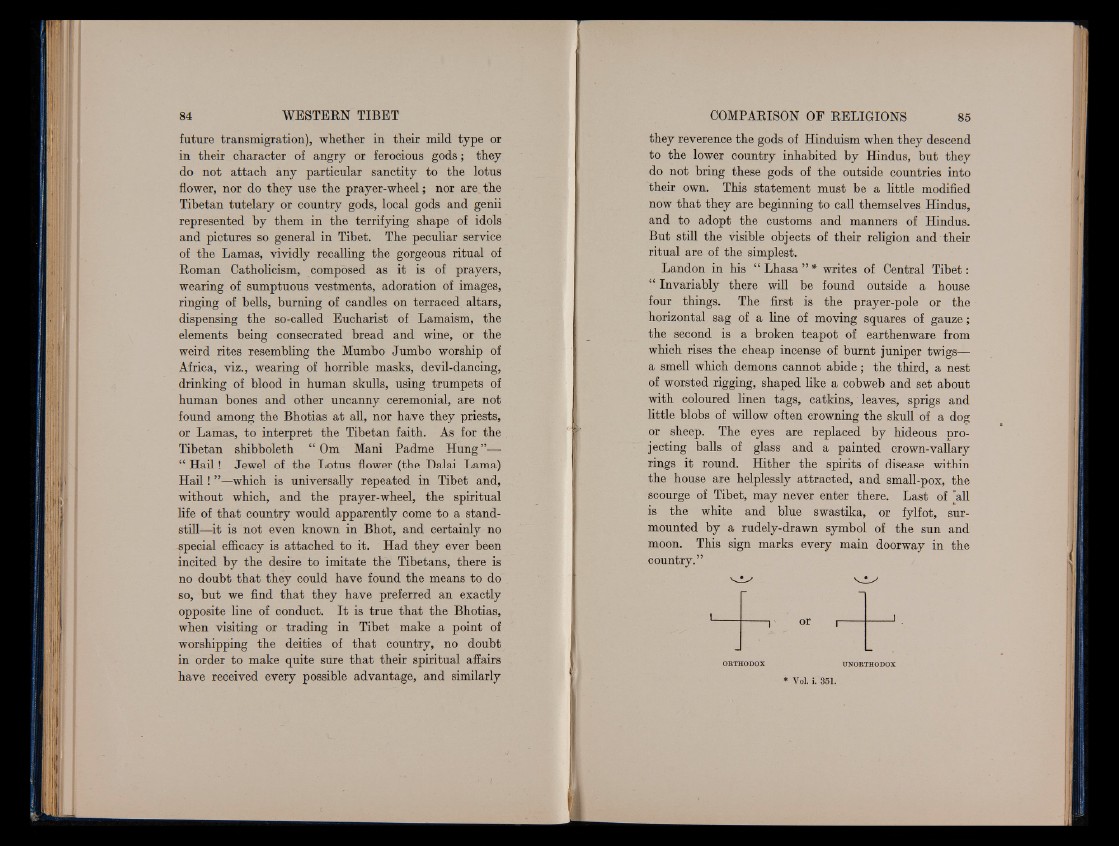
future transmigration), whether in their mild type or
in their character of angry or ferocious gods; they
do not attach any particular sanctity to the lotus
flower, nor do they use the prayer-wheel; nor are. the
Tibetan tutelary or country gods, local gods and genii
represented by them in the terrifying shape of idols
and pictures so general in Tibet. The peculiar service
of the Lamas, vividly recalling the gorgeous ritual of
Roman Catholicism, composed as it is of prayers,
wearing of sumptuous vestments, adoration of images,
ringing of bells, burning of candles on terraced altars,
dispensing the so-called Eucharist of Lamaism, the
elements being consecrated bread and wine, or the
weird rites resembling the Mumbo Jumbo worship of
Africa, viz., wearing of horrible masks, devil-dancing,
drinking of blood in human skulls, using trumpets of
human bones and other uncanny ceremonial, are not
found among the Bhotias at all, nor have they priests,
or Lamas, to interpret the Tibetan faith. As for the
Tibetan shibboleth “ Om Mani Padme Hung ”—
“ H a il! Jewel of the Lotus flower (the Dalai Lama)
H a il! ”—which is universally repeated in Tibet and,
without which, and the prayer-wheel, the spiritual
life of that country would apparently come to a standstill—
it is not even known in Bhot, and certainly no
special efficacy is attached to it. Had they ever been
incited by the desire to imitate the Tibetans, there is
no doubt that they could have found the means to do
so, but we find that they have preferred an exactly
opposite line of conduct. I t is true that the Bhotias,
when visiting or trading in Tibet make a point of
worshipping the deities of that country, no doubt
in order to make quite sure that their spiritual affairs
have received every possible advantage, and similarly
they reverence the gods of Hinduism when they descend
to the lower country inhabited by Hindus, but they
do not bring these gods of the outside countries into
their own. This statement must be a little modifieri
now that they are beginning to call themselves Hindus,
and to adopt the customs and manners of Hindus.
But still the visible objects of their religion and their
ritual are of the simplest.
Landon in his “ Lhasa ” * writes of Central Tibet:
“ Invariably there will be found outside a house
four things. The first is the prayer-pole or the
horizontal sag of a line of moving squares of gauze;
the second is a broken teapot of earthenware from
which rises the cheap incense of burnt juniper twigs—
a smell which demons cannot abide; the third, a nest
of worsted rigging, shaped like a cobweb and set about
with coloured linen tags, catkins, leaves, sprigs and
little blobs of willow often crowning the skull of a dog
or sheep. The eyes are replaced by hideous projecting
balls of glass and a painted crown-vallary
rings it round. Hither the spirits of disease within
the house are helplessly attracted, and small-pox, the
scourge of Tibet, may never enter there. Last of [all
is the white and blue swastika, or fylfot, surmounted
by a rudely-drawn symbol of the sun and
moon. This sign marks every main doorway in the
country.”
or
ORTHODOX UNORTHODOX
* V o l. i. 3 5 1 .